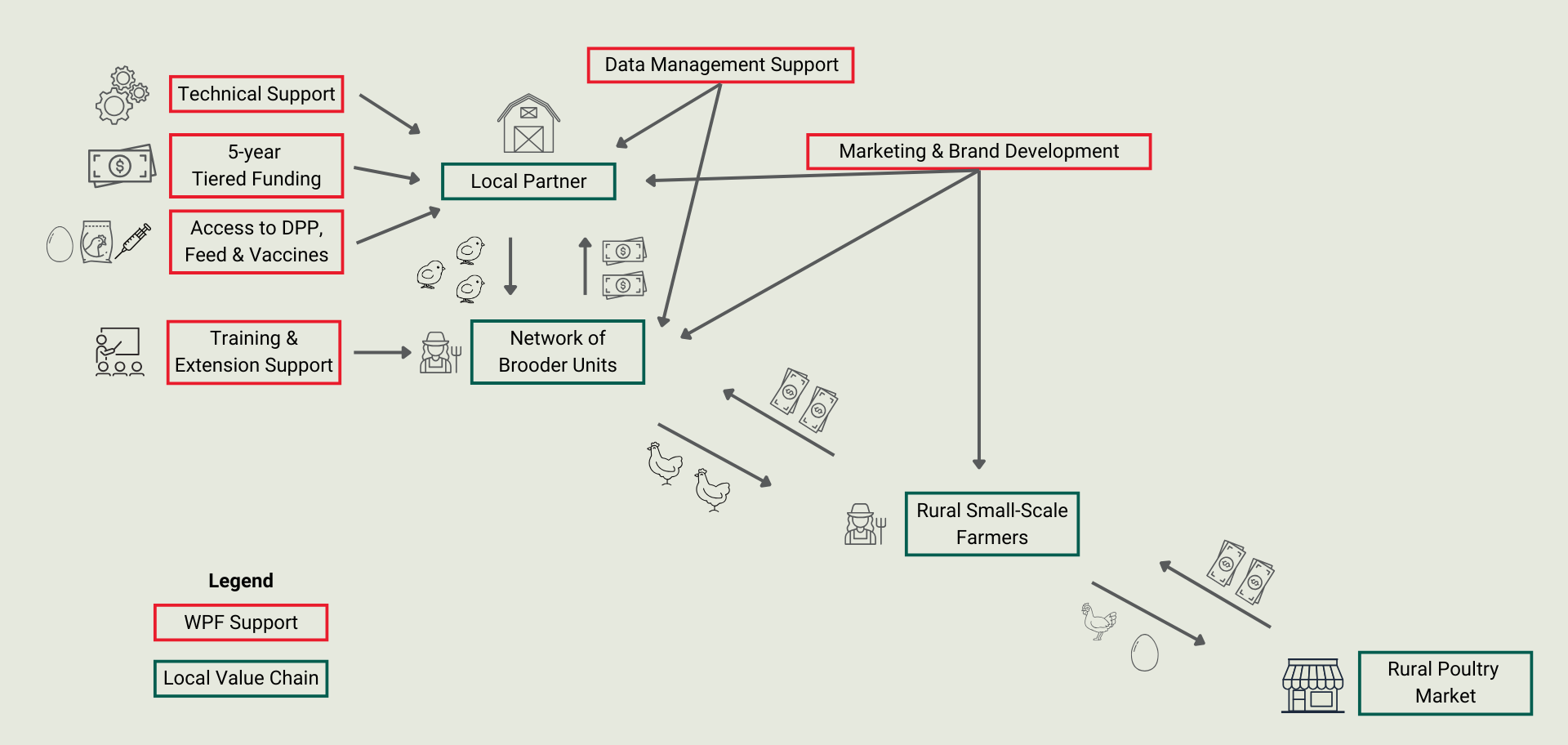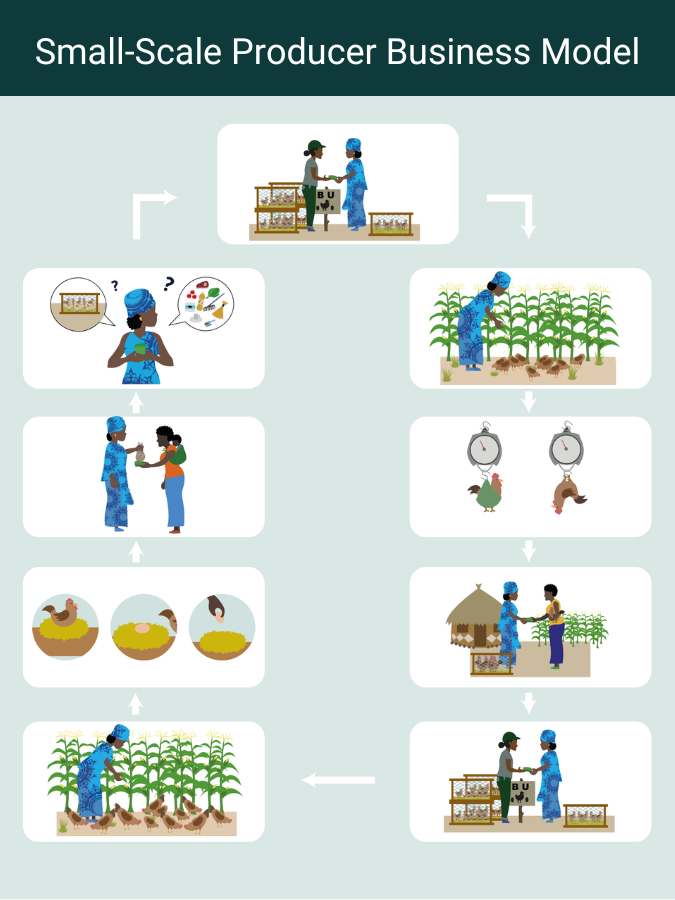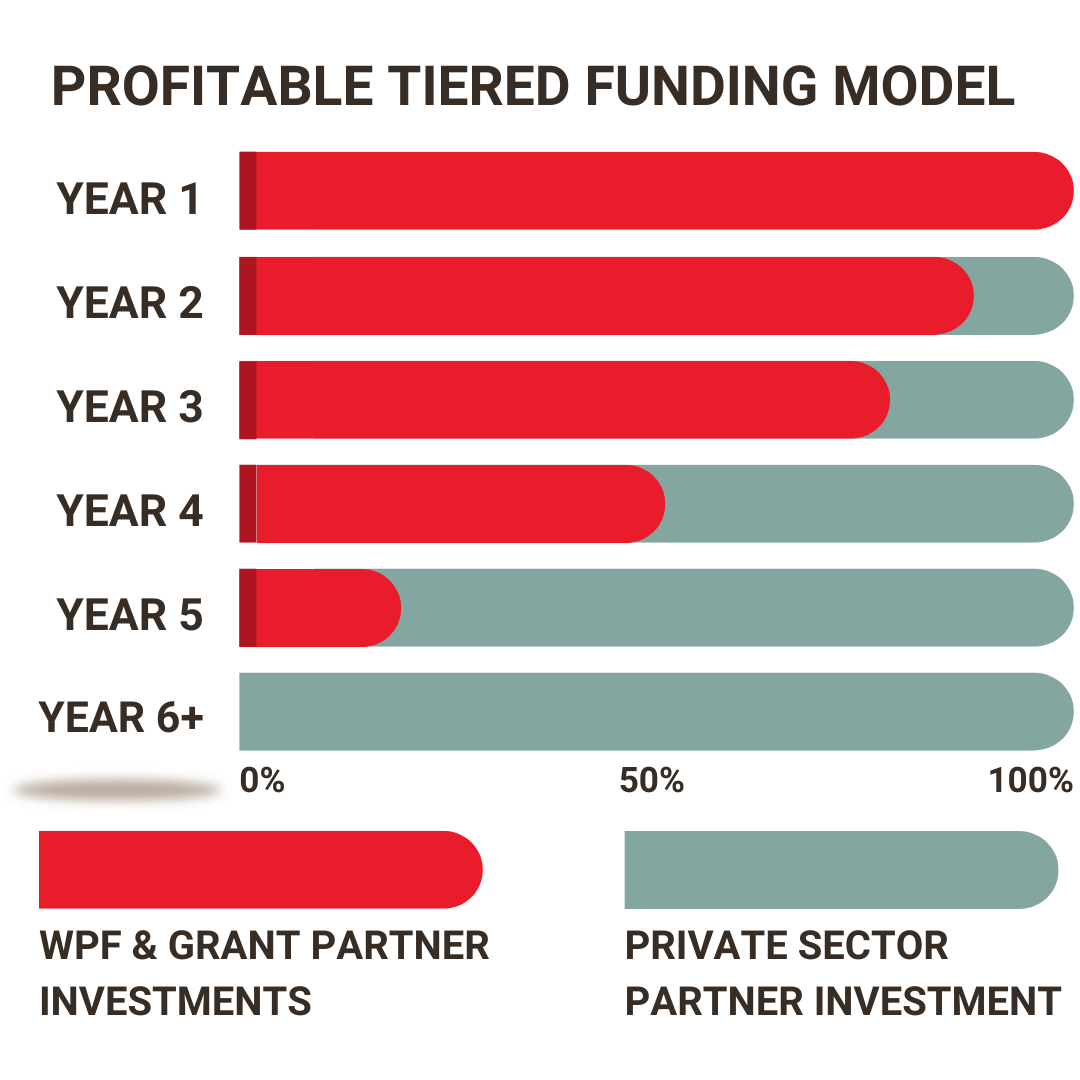By: Randall Ennis, Maureen Stickel, James Ferns and Jan de Jonge
Profitability is at the heart of the World Poultry Foundation’s (WPF) African Poultry Multiplication Initiative (APMI). APMI is a poultry sector development program focusing on long-term sustainability and scalability. Launching a Dual-Purpose Poultry (DPP) business requires significant upfront investment before generating revenue, which can make the model risky for private sector partners. WPF helps de-risk this investment by providing strategic guidance and support, allowing businesses to navigate the early stages with confidence. Our focus on financial viability means that once the dual-purpose value chain becomes profitable for our private-sector partner, they can reinvest in growth, innovate, and continue delivering impact long after our involvement.
“Profitability is core to the WPF approach because working with live chickens is inherently sensitive. If one link in the value chain loses value, the entire system can break down,” notes James Ferns, WPF’s Financial Controller. “Ensuring that every stakeholder realizes profit preserves the integrity of the whole chain and supports sustainable, long-term growth.”
Setting The Scene for Long-Term Sustainability and Investment
Financial sustainability is crucial for creating lasting change, and it is the primary consideration from the very beginning of each APMI program.
“Before launching a DPP program in a new country, we conduct an in-depth market analysis to assess the financial feasibility and potential for success of the APMI. This evaluation includes examining key factors such as feed costs, market prices for eggs and meat, labor rates, utility rates, transportation costs, and fuel. All of this data is incorporated into a P&L model developed by WPF,” says WPF CEO, Randall Ennis. “If the initial analysis shows promising results, we select an implementing partner for the APMI. Once the partner is chosen, we revisit the identified cost centers, working closely with the private sector company to incorporate their local knowledge and insights. This collaboration helps highlight the key drivers of profitability.”
When local poultry businesses generate profit, they are better equipped to secure new investments and build resilience.This ensures the value chain remains sustainable without relying on long-term donor funding for operations. It also guarantees continuous access to essential inputs—such as day-old chicks, feed, and teen birds—while boosting confidence among local entrepreneurs and investors.
How Each Player in the Value Chain Profits
Profitability is envisioned at every level of the poultry value chain. Each player—private sector partners, feed mills, brooder units, and small-scale poultry producers— must generate income through the program to ensure its long-term success.
- Private Sector Partners: These are often hatcheries or integrated poultry companies producing day-old chicks (DOC). Their profitability hinges on efficient production processes, high-quality breeding stock, and well-managed distribution networks.By supplying healthy, well-vaccinated DOCs and ensuring access to high-quality inputs such as specialized feed and vaccines, private sector partners help drive high survival rates and strong performance down the value chain. This leads to repeat business and increased market share. Private sector partners benefit from the scale of demand created by the program and the consistent need for quality inputs. Their profitability also comes from building long-term supply relationships and enhancing their market position by consistently delivering high-quality products.
- Feed Mills: High-quality feed is essential for bird health and productivity. Feed mills profit by meeting the increasing demand for nutritious, well-formulated poultry feed. Consistent production and supply of quality feed not only support strong growth performance for birds but also build customer loyalty. Feed mills’ profitability grows as they scale operations and streamline logistics, reducing costs while maintaining product quality.
- Brooder Units (BUs): These entrepreneurs specialize in raising DOCs to 4–6 weeks, selling them as strong, well-conditioned teen birds. BUs maximize their total revenue by maintaining low mortality rates and boost profitability by minimizing input costs and ensuring good growth performance. The key to their profitability lies in efficient management—optimizing feed use (their most expensive input), maintaining biosecurity, and selling birds at the right time to avoid additional costs. By providing a steady supply of healthy birds to small-scale producers, BUs establish themselves as essential players in the value chain. Their profitability also increases as they scale operations, expand their customer base, and build a reputation for reliability and quality.
 Small-Scale Poultry Producers (SSPs): SSPs often capture the highest margins by minimizing input costsand maximizing the value of their output. They typically raise teen birds to market weight or maintain hens for egg production. By allowing birds to forage and minimizing feed supplementing, SSPs reduce expenses while producing high-quality meat and eggs. The fast-growing males fetch a premium price, while the laying hens provide a steady source of income through egg sales. SSPs’ profitability increases as they improve flock management, reduce disease losses, and access better markets for their products.
Small-Scale Poultry Producers (SSPs): SSPs often capture the highest margins by minimizing input costsand maximizing the value of their output. They typically raise teen birds to market weight or maintain hens for egg production. By allowing birds to forage and minimizing feed supplementing, SSPs reduce expenses while producing high-quality meat and eggs. The fast-growing males fetch a premium price, while the laying hens provide a steady source of income through egg sales. SSPs’ profitability increases as they improve flock management, reduce disease losses, and access better markets for their products.
“If everyone in the value chain is making a profit—the private-sector company(s), the brooder unit, and the small-scale producers—these entrepreneurs will thrive and grow their businesses, resulting in more household income and improved nutrition through eggs and meat for rural families,” says Jan de Jonge, WPF’s Senior Program Director for Africa.
Key Steps to Ensure Profitability and Future Innovations
WPF supports every stage of the value chain with targeted interventions and support throughout the 5-year APMI program:
- Partner Selection: We prioritize companies with existing experience in chick and feed production. Companies without this background often face steep learning curves, diverting focus from market development and slowing program success.
- Strong Vetting and Brooder Unit (BU) Selection: Early rollouts of APMI taught us the importance of thorough BU vetting. We now prioritize selecting BUs capable of maintaining operational and quality standards
- Financial Modeling & Reporting: We regularly update cost models to help our partners understand and control expenses. Detailed profitability analyses help each stakeholder identify cost-saving opportunities and areas for growth.
- Technical and Marketing Support: Our field teams provide hands-on training in efficient production practices, market development, and biosecurity. This ensures that each player can maximize productivity and profitability.
- Capacity Building: We strengthen financial literacy through training programs, ensuring that partners can accurately track performance and make informed decisions. We also support business planning and investment strategies to promote long-term growth.
- Data Collection and Monitoring: We use robust data collection and monitoring systems to track performance and identify areas for improvement. This allows us to make real-time adjustments, ensuring the program remains on track and adapts to changing conditions.
- Flexibility in Program Implementation: We’ve learned the value of adapting our approach to local cultural and market dynamics, allowing for smoother implementation and stronger partner engagement.
We are also exploring innovative strategies to further support profitability, including:
- Connecting partners directly with raw material suppliers to reduce feed costs.
- Facilitating peer learning and developing “graduation models” that encourage incremental growth in production and investment.
- Investigating digital tools to enhance data collection, performance tracking, and market linkages.
- Developing innovative financing models, such as microloans and revolving credit facilities, to help small-scale producers invest in their businesses and expand their operations.
Driving Social Impact Through Sustainable Business Models
Profitability extends beyond financial success—it is a catalyst for social change. When every stakeholder in the poultry value chain achieves profitability, increased household incomes lead to improved nutrition, education, and overall community well-being. Profitability creates a positive feedback loop, encouraging new investments and the replication of successful models.
Profitability is not just a financial metric—it is a necessary condition to transform communities. From enabling families to send their children to school to empowering women to become community leaders, the benefits of a profitable poultry sector are far-reaching. As profitable value chains expand, they drive further economic activity, strengthening local markets and ensuring sustainable food security.
 By integrating these financial strategies with our social mission, WPF is paving the way for a resilient poultry sector that continues to thrive independently, creating lasting change for generations to come, and change that can continue to thrive and grow without further infusions of donor funds.
By integrating these financial strategies with our social mission, WPF is paving the way for a resilient poultry sector that continues to thrive independently, creating lasting change for generations to come, and change that can continue to thrive and grow without further infusions of donor funds.
“When the entire system is profitable, small-scale producers feel empowered to expand their flocks and invest in better practices. This leads to stronger businesses and healthier communities,” says Maureen Stickel, WPF’s Director of International Program Development.
The APMI Program is being implemented in The Gambia and Sierra Leone with generous funding from the Qatar Fund for Development (QFFD).
CATEGORY
LOCATION